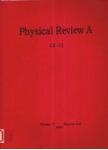版权所有:内蒙古大学图书馆 技术提供:维普资讯• 智图
内蒙古自治区呼和浩特市赛罕区大学西街235号 邮编: 010021

作者机构:Department of Computer Science and Institute for Advanced Computer Studies University of Maryland College Park Maryland 20742 USA and Mathematical and Computational Sciences Division National Institute of Standards and Technology Gaithersburg Maryland 20899 USA IDA Center for Computing Sciences 17100 Science Drive Bowie Maryland 20715-4300 USA Institute for Quantum Optics and Quantum Information of the Austrian Academy of Sciences A-6020 Innsbruck Austria
出 版 物:《Physical Review A》 (物理学评论A辑:原子、分子和光学物理学)
年 卷 期:2006年第74卷第3期
页 面:032334-032334页
核心收录:
学科分类:070207[理学-光学] 07[理学] 08[工学] 0803[工学-光学工程] 0702[理学-物理学]
基 金:National Science Foundation NSF (0204084 0514213)
摘 要:Robust quantum computation with d-level quantum systems (qudits) poses two requirements: fast, parallel quantum gates and high-fidelity two-qudit gates. We first describe how to implement parallel single-qudit operations. It is by now well known that any single-qudit unitary can be decomposed into a sequence of Givens rotations on two-dimensional subspaces of the qudit state space. Using a coupling graph to represent physically allowed couplings between pairs of qudit states, we then show that the logical depth (time) of the parallel gate sequence is equal to the height of an associated tree. The implementation of a given unitary can then optimize the tradeoff between gate time and resources used. These ideas are illustrated for qudits encoded in the ground hyperfine states of the alkali-metal atoms Rb87 and Cs133. Second, we provide a protocol for implementing parallelized nonlocal two-qudit gates using the assistance of entangled qubit pairs. Using known protocols for qubit entanglement purification, this offers the possibility of high-fidelity two-qudit gates.